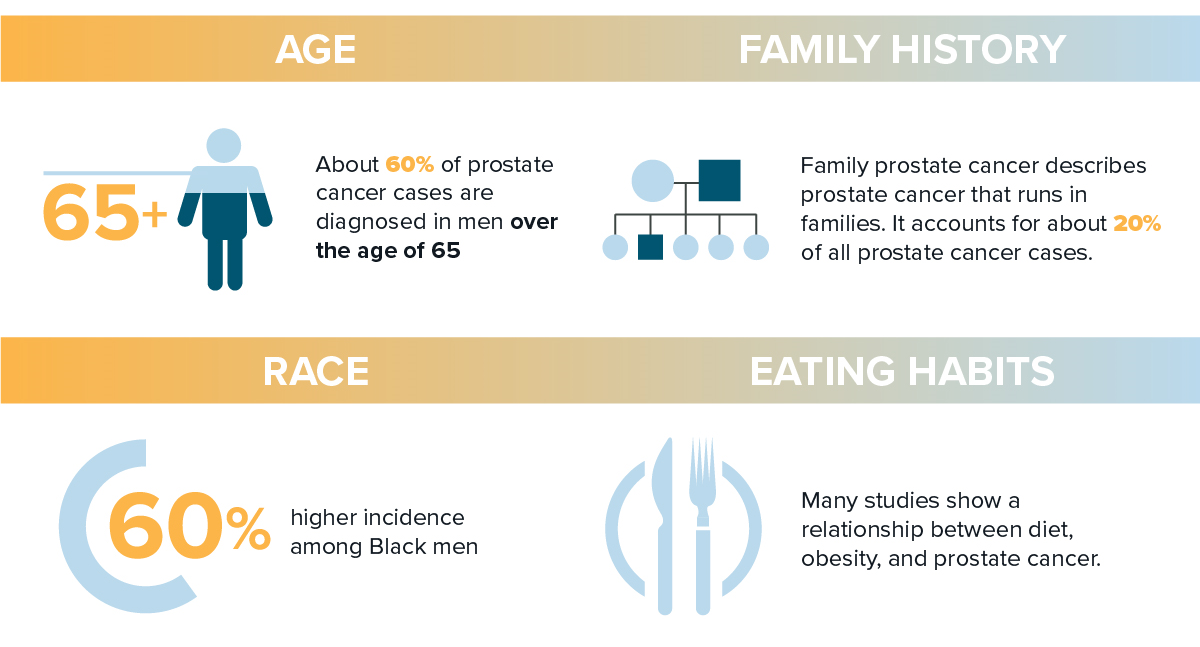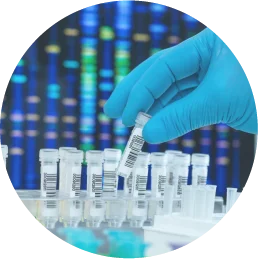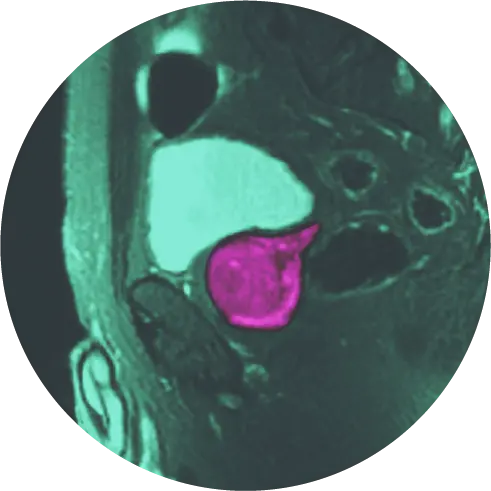Statistics have the power to motivate people to recognize symptoms, assess their risk factors, and get screened. Let’s look at prostate cancer in more detail and the statistics you need to know to make informed decisions about your health.
What Exactly Is Prostate Cancer?
The prostate is located inside the groin between the penis and the rectum. It lies just below the bladder, with the urethra running through the center. Prostate cancer occurs when prostate cells keep replicating instead of dying, crowding out normal cells. Prostate cancer is a solid tumor rather than a blood cancer like leukemia.
Who Is at Risk for Prostate Cancer?

All men are at risk for prostate cancer. Risk factors are conditions that increase your chances of developing a disease.
Assessing specific risk factors for prostate cancer can help you evaluate your situation and whether you should get screening. It’s important to note that some men with risk factors may never get prostate cancer.
Age
About 66% of prostate cancer cases are diagnosed in men over the age of 65. Approximately 80% of men over the age of 80 have cancer cells in their prostate. If you have a family history of prostate cancer or are Black, your risk increases at age 40.1
Family History
Familial prostate cancer describes prostate cancer that runs in families.2 It accounts for about 20% of all prostate cancer cases. This likely has to do with shared genetics, lifestyle, and shared environmental factors.
Race
Race is a significant and critical risk factor for prostate cancer. In the United States, the incidence among Black men is 60% higher than among Caucasian men. The mortality rate for Black men is twice that of Caucasian men.3 Prostate cancer in Black men also develops at a younger age than in Caucasian men. Due to this statistic, Black men should start discussing PSA screening with their doctor at age 40.
Hereditary Breast and Ovarian Cancer Syndrome (HBOC)
Men can also receive a diagnosis of HBOC which indicates a specific type of inherited genetic risk, usually accompanied by several cases of breast and ovarian cancer on one side of the family. Men with HBOC are at an increased risk for a more aggressive form of prostate cancer as well as breast cancer.4
Eating Habits
Although there is no definitive link between diet and prostate cancer, many studies show a relationship between diet, obesity, and an increased risk of prostate cancer. Eating high-fat foods has been associated with a higher risk of prostate cancer, however research is still ongoing to confirm the association between diet and increased risk.5
How Many Men Will Get Prostate Cancer?
Prostate cancer is the most common cancer among men, second only to skin cancer. It’s estimated that in 2022 about 270,000 men in the United States will be diagnosed with prostate cancer. In fact, it is the fourth most diagnosed cancer in the world.6 About 13 out of every 100 men will get prostate cancer during their lifetime, and about 2 to 3 out of every 100 men will die from the disease.7
What Is the Survival Rate for Prostate Cancer?

It is estimated that about 34,500 men will die from prostate cancer this year. Prostate cancer is second only to lung cancer as a leading cause of cancer death in the United States.8
Fortunately, about 80-85% of prostate cancers are found when the disease is localized to the prostate. For men whose prostate cancers are found early and confined to the prostate, the 5-year survival rate is nearly 100%. The ten-year survival rate is 98%, and the fifteen-year survival rate is 95%. These numbers assume the cancer does not grow in the meantime.
Stage IV prostate cancer has a five-year survival rate of 28%.9 When prostate cancer spreads to distant locations, the 5-year survival rate is 31%.10
Recurrence Rate for Prostate Cancer
About 20-30% of men will have a positive PSA five years after treatment. The likelihood of recurrence depends on how aggressive the cancer is.
Here are some signs that there may be a possible recurrence of prostate cancer:
- If prostate cancer has spread to the Lymph nodes in the pelvic region, they may be at higher risk for recurrence.
- The larger the tumor, the greater the chance of recurrence.
- Your Gleason Score; the higher your Gleason Score is, the greater the chance for recurrence. The Gleason Score is based on the results of a biopsy.11
- The stage of prostate cancer is a critical factor in determining treatment options.12 The stage describes the extent of spreading and treatment options, and it also helps predict the likelihood of recurrence.
What are the Symptoms of Prostate Cancer?
Men experience prostate cancer in different ways, and there are often no early warning signs.13 In some cases, men may experience symptoms:
- Frequent and urgent urination
- Difficulty holding back urination
- A weak or interrupted flow while urinating
- Painful urination
- Erectile dysfunction
- Painful ejaculation
- Blood in the urine or semen
- Pressure or pain in the rectum
- Pain or stiffness in the lower back, hips, pelvis, or thighs
What Is the Treatment for Prostate Cancer?
There are many treatment options for prostate cancer, depending on how advanced it is. Treatment decisions are based on several factors, including the cancer stage, need for therapy, level of risk, anticipated life expectancy, a person’s overall health, and personal preference.
One study found that over a five-year period, there was a threefold decline in the number of men with low-risk prostate cancer opting for surgery.14 They chose to monitor instead. Monitoring of prostate cancer is called “active surveillance.” The American Society of Clinical Oncology (ASCO) recommends that active surveillance follow a schedule that includes a PSA test every 3-6 months, a prostate biopsy every 6-12 months, and a digital rectal exam once a year.
However, if the cancer has metastasized, more aggressive treatment might be necessary, such as radiation, chemotherapy, hormone therapy, ultrasound, or medications.
What Should Men Do if They’re Diagnosed with Prostate Cancer?
Statistics can be overwhelming to evaluate, but they play an important role in assessing your risk factors for prostate cancer. When deciding which type of prostate cancer treatment to choose, it is important to consider how each treatment differs and how this may impact the treatment results. HALO diagnostics offers minimally invasive therapies like laser focal therapy, HIFU, cryotherapy, and TULSA-PRO. Laser focal therapy boasts many benefits for patients compared to other treatment methods for prostate cancer. No general anesthesia is required for the therapy, and patients are able to return to work as early as the day after the operation. Additionally, laser focal therapy carries lower risk of side effects compared to other treatment methods such as, impotence, and urinary incontinence.15
If you’re ready to take control of your prostate health, please fill out the form below to get in touch with one of our prostate experts today or give us a call at 877-225-2831.
References
1 https://www.webmd.com/prostate-cancer/guide/prostate-cancer-risk-factors
2 https://www.cancer.net/cancer-types/prostate-cancer/risk-factors-and-prevention
3 https://www.ncbi.nlm.nih.gov/pmc/articles/PMC8987139/
4 https://www.cancer.net/cancer-types/prostate-cancer/risk-factors-and-prevention
5 https://www.ncbi.nlm.nih.gov/pmc/articles/PMC4091618/
6 https://www.cancer.net/cancer-types/prostate-cancer/statistics
7 https://www.cdc.gov/cancer/prostate/basic_info/risk_factors.htm
8 https://www.cancer.org/cancer/prostate-cancer/about/key-statistics.html
10 https://www.cancer.org/cancer/prostate-cancer/detection-diagnosis-staging/survival-rates.html
11 https://www.webmd.com/prostate-cancer/prostate-cancer-stages
13 https://www.pcf.org/about-prostate-cancer/what-is-prostate-cancer/prostate-cancer-symptoms-signs/
14 https://www.webmd.com/prostate-cancer/news/20190212/more-men-holding-off-on-prostate-cancer-surgery
15 Journal of Urology Vol 203, No. 4S, Supplement, May 15, 2020: e369




